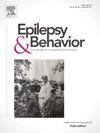非病变局灶性癫痫患儿停药后癫痫复发风险
IF 2.3
3区 医学
Q2 BEHAVIORAL SCIENCES
引用次数: 0
摘要
目的:研究局灶性癫痫(FE)患儿停用抗癫痫药物(ASM)后癫痫复发的风险,这些患儿通过ASM单药治疗而非药物替代导致癫痫发作缓解。方法1999年7月1日至2015年6月30日在我院就诊。排除脑MRI和自限性FE异常的儿童。所有儿童在无癫痫发作状态超过2年后停止使用asm。评估ASM停药后2年内癫痫复发与发病年龄、ASM停药前无癫痫发作间隔、逐渐减少持续时间、脑电图(EEG)间期癫痫样放电(IEDs)的存在以及所用ASM类型之间的关系。结果研究对象为128名FE儿童。12例(9.7%)癫痫复发。复发组的发病年龄和ASM戒断年龄均显著高于非复发组(p <;分别为0.0001和p = 0.0003)。复发组ASM停药前无癫痫发作间隔(平均2.6年)明显短于非复发组(3.6年;p & lt;0.0001)。复发组的减量持续时间(平均5.3个月)明显短于非复发组(9.2个月;p & lt;0.0001)。复发组出现ied的频率明显高于未复发组(p = 0.03)。左乙拉西坦组癫痫发作复发率低于卡马西平组,但差异无统计学意义(p = 0.067)。结论:在使用ASM达到无癫痫状态超过3年的FE患儿中,临床医生应建议使用持续6个月以上的缓慢逐渐减量的ASM停药方案。本文章由计算机程序翻译,如有差异,请以英文原文为准。
Seizure-relapse risk following antiseizure medication withdrawal in children with non-lesional focal epilepsy
Aims
We investigated seizure-relapse risk following antiseizure medication (ASM) withdrawal in children with focal epilepsy (FE) who were leading to seizure remission by ASM monotherapy without drug replacement.
Methods
Participants were treated at our hospital between 1 July 1999 and 30 June 2015. Children showing abnormalities on brain MRI and self-limited FE were excluded. All children discontinued ASMs after more than 2 years of a seizure-free state. Associations between seizure relapse within 2 years following ASM withdrawal and age at onset, seizure-free interval before ASM withdrawal, duration of tapering, presence of interictal epileptiform discharges (IEDs) on electroencephalogram (EEG), and type of ASM used were evaluated.
Results
Participants comprised 128 FE children. Twelve children (9.7 %) experienced seizure relapse. Ages at both onset and ASM withdrawal were significantly higher in the relapse group than in the non-relapse group (p < 0.0001 and p = 0.0003, respectively). Seizure-free interval before ASM withdrawal was significantly shorter in the relapse (mean, 2.6 years) than in the non-relapse group (3.6 years; p < 0.0001). Duration of tapering was significantly shorter in the relapse (mean, 5.3 months) than in the non-relapse group (9.2 months; p < 0.0001). Presence of IEDs was significantly more frequent in the relapse than in the non-relapse group (p = 0.03). Seizure relapse tended to be less frequent with levetiracetam treatment than with carbamazepine, but the difference was not significant (p = 0.067).
Conclusions
Among FE children who achieve a seizure-free state on ASMs for more than 3 years, clinicians should recommend withdrawal of ASM using a slow tapering schedules lasting more than 6 months.
求助全文
通过发布文献求助,成功后即可免费获取论文全文。
去求助
来源期刊

Epilepsy & Behavior
医学-行为科学
CiteScore
5.40
自引率
15.40%
发文量
385
审稿时长
43 days
期刊介绍:
Epilepsy & Behavior is the fastest-growing international journal uniquely devoted to the rapid dissemination of the most current information available on the behavioral aspects of seizures and epilepsy.
Epilepsy & Behavior presents original peer-reviewed articles based on laboratory and clinical research. Topics are drawn from a variety of fields, including clinical neurology, neurosurgery, neuropsychiatry, neuropsychology, neurophysiology, neuropharmacology, and neuroimaging.
From September 2012 Epilepsy & Behavior stopped accepting Case Reports for publication in the journal. From this date authors who submit to Epilepsy & Behavior will be offered a transfer or asked to resubmit their Case Reports to its new sister journal, Epilepsy & Behavior Case Reports.
 求助内容:
求助内容: 应助结果提醒方式:
应助结果提醒方式:


